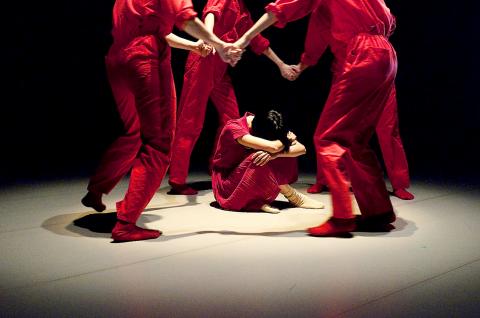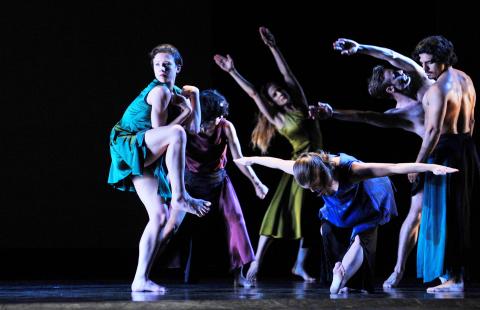Buoyancy and light were the order of the day at the National Theater in Taipei last weekend, while the Experimental Theater was filled with loneliness and despair — and cherry red jumpsuits.
The Mark Morris Dance Group on Saturday night exceeded the high expectations that had heralded its arrival, while Scarecrow Contemporary Dance Company’s (稻草人現代舞蹈團) latest production, Singular (單‧身), upstairs in the Experimental Theater earlier in the day, gave a rather depressing outlook on life.
Morris’ mixed program opened with a recent work, last year’s Crosswalk, set to Carl Maria von Weber’s Grand Duo Concertant, for Clarinet and Piano, which was light and lyrical, though with a hint of underlying darkness. The work exemplifies his musicality and imagination. The dancers — women dressed in tangerine and orange tops and skirts, the men in white T-shirts and dark pants — run, skip and tumble across the stage in bursts of energy. However, in the midst of all this fun, pushing and shoving between two women and one man belie the lightness that surround them.

Credit: Courtesy of Liu Ren-haur / Scarecrow Contemporary Dance Company
All Fours, from 2003, is set to Bela Bartok’s String Quartet No. 4, emitted a much darker mood. The demanding music evokes feelings of uncertainty, which are reflected in the stark, harsh movements of the dancers, who frequently clasp their hands above their heads as if in desperate prayer.
Symmetry is key to Festival Dance which premiered in 2011 and is set to Johann Nepomuk Hummel’s Piano Trio No. 5 in E Major. The piece begins and ends with a couple embracing to the right of the stage. The 12 dancers twirl in pairs or divide in half, joining hands for geometric line dancing. The movements are reminiscent of simpler times, of village fetes and harvest celebrations, and brought to mind Jerome Robbins’ Dances at a Gathering. The piece represents what so many love about Morris’ work — the lush romantic lyricism and grace of classical ballet, but without the tutus, tights and toe shoes.
A key element to all three works on the program was that the dancers were accompanied by the troupe’s seven-man music ensemble, in various formations. The rippling notes of the piano appeared to give added lift to the dancers in Crosswalk and Festival Dance. Dance just seems to breathe to live music and music has always been the key to Morris’ works.

Photo: Mandy Cheng, AFP
The Mark Morris Dance Group will perform at the Tainan Municipal Cultural Center in Greater Tainan tomorrow and Friday. Friday night will be the same program I saw; tomorrow night is Program A, which is composed of two pieces set to Mozart — Eleven, set to Piano Concerto No. 11 in F major, K. 413, and Double, set to Sonata for Two Pianos in D major, K. 448 and Grand Duo, which is set to Lou Harrison’s Grand Duo for Violin and Piano.
Scarecrow artistic director and choreographer Luo Wen-jinn (羅文瑾) cited US author Paul Auster’s The Invention of Solitude as inspiration for Singular, which follows a “Time Wanderer” — whose image was derived from Luo’s father — through different eras and a multitude of meetings, partings, separations and rejections.
A quick look at the names of some of the other characters in the program and it is easy to see there will be no happy endings: Kid Without Love, Lonely Woman, Mother With Hollow Soul and Rejected Girl.
Luo shows that isolation is not just a human concept, with her fighting fish scenes and a flock of panicked birds. The pain comes from the repeated attempts by the rejected to insert themselves into pairings and group activities despite continual rebuffs.
The vast white tiled wall that formed the backdrop to Singular conveyed both an image of modern urban in Taiwan, with its omnipresent tiled apartment buildings, and formed a barrier that kept the characters trapped within their stories.
Despite the painful subject, the choreography and the eight dancers, including Luo herself, were always interesting to watch. Most of the dancers portrayed multiple roles that required repeated quick costume changes, so kudos to their off-stage helpers who made that happen.
With Singular, Scarecrow Contemporary Dance Company continues to demonstrate that a troupe does not have to be based in Taipei to remain topical, edgy or adventurous.
This story has been amended since first published to correct the photo captions.

Oct. 21 to Oct. 27 Sanbanqiao Cemetery (三板橋) was once reserved for prominent Japanese residents of Taipei, including former governor-general Motojiro Akashi, who died in Japan in 1919 but requested to be buried in Taiwan. Akashi may have reconsidered his decision if he had known that by the 1980s, his grave had been overrun by the city’s largest illegal settlement, which contained more than 1,000 households and a bustling market with around 170 stalls. Fans of Taiwan New Cinema would recognize the slum, as it was featured in several of director Wan Jen’s (萬仁) films about Taipei’s disadvantaged, including The Sandwich

“Wish You Luck is not just a culinary experience, it’s a continuation of our cultural tradition,” says James Vuong (王豪豐), owner of the Daan District (大安) Hong Kong diner. On every corner of Kowloon, diners pack shoulder-to-shoulder over strong brews of Hong-Kong-style milk tea, chowing down on French Toast and Cantonese noodles. Hong Kong’s ubiquitous diner-style teahouses, known as chachaanteng (茶餐廳), have been a cultural staple of the city since the 1950s. “They play an essential role in the daily lives of Hongkongers,” says Vuong. Wish You Luck (祝您行運) offers that same vibrant melting pot of culture and cuisine. In

Much noise has been made lately on X (Twitter), where posters both famed and not have contended that Taiwan is stupid for eliminating nuclear power, which, the comments imply, is necessary to provide the nation with power in the event of a blockade. This widely circulated claim, typically made by nuclear power proponents, is rank nonsense. In 2021, Ian Easton, an expert on Taiwan’s defenses and the plans of the People’s Liberation Army (PLA) to break them, discussed the targeting of nuclear power plants in wartime (“Ian Easton On Taiwan: Are Taiwan’s nuclear plants safe from Beijing?”, April 12, 2021). The

Artificial intelligence could help reduce some of the most contentious culture war divisions through a mediation process, researchers say. Experts say a system that can create group statements that reflect majority and minority views is able to help people find common ground. Chris Summerfield, a co-author of the research from the University of Oxford, who worked at Google DeepMind at the time the study was conducted, said the AI tool could have multiple purposes. “What I would like to see it used for is to give political leaders ... a better sense of what people ... really think,” he said, noting surveys gave